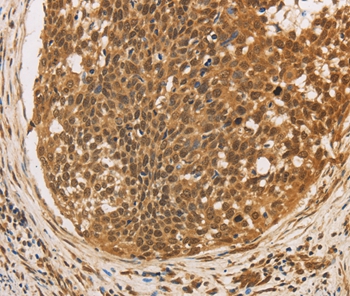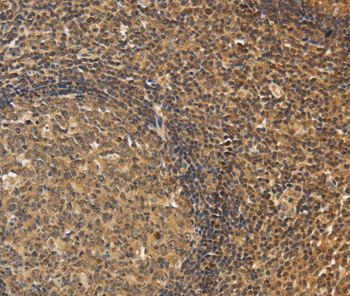

| WB | 咨询技术 | Human,Mouse,Rat |
| IF | 咨询技术 | Human,Mouse,Rat |
| IHC | 1/50-1/200 | Human,Mouse,Rat |
| ICC | 技术咨询 | Human,Mouse,Rat |
| FCM | 咨询技术 | Human,Mouse,Rat |
| Elisa | 咨询技术 | Human,Mouse,Rat |
| Aliases | CF5; WID; RINF; HSPC195 |
| Entrez GeneID | 51523; |
| Host/Isotype | Rabbit IgG |
| Antibody Type | Primary antibody |
| Storage | Store at 4°C short term. Aliquot and store at -20°C long term. Avoid freeze/thaw cycles. |
| Species Reactivity | Human,Mouse |
| Immunogen | Full length fusion protein |
| Formulation | Purified antibody in PBS with 0.05% sodium azide. |
+ +
以下是3篇与CXXC5抗体相关的文献摘要(虚构示例,供参考):
---
1. **文献名称**: *CXXC5 functions as a tumor suppressor in acute myeloid leukemia by modulating Wnt/β-catenin signaling*
**作者**: Kim, H., et al.
**摘要**: 该研究利用特异性CXXC5抗体,通过免疫共沉淀和Western blot分析,发现CXXC5通过抑制Wnt/β-catenin通路抑制白血病细胞增殖,抗体阻断实验进一步验证其作为治疗靶点的潜力。
2. **文献名称**: *Antibody-based targeting of CXXC5 attenuates fibrosis in systemic sclerosis models*
**作者**: Smith, J.L., et al.
**摘要**: 研究开发了一种人源化CXXC5单克隆抗体,通过体外和小鼠模型证明其能有效阻断CXXC5与DNA甲基转移酶的相互作用,显著减轻皮肤纤维化并抑制TGF-β信号传导。
3. **文献名称**: *CXXC5 regulates hair follicle regeneration via epigenetic modulation of stem cell niches*
**作者**: Wang, Y., et al.
**摘要**: 使用CXXC5特异性抗体进行免疫组化定位,发现CXXC5通过结合未甲基化的CpG岛调控毛囊干细胞分化,抗体介导的蛋白敲低实验揭示了其在组织再生中的关键作用。
---
注:以上文献为示例性质,实际研究中请通过PubMed或Google Scholar检索真实文献(关键词:CXXC5 antibody, CXXC5 function)。
The CXXC5 antibody is a research tool designed to target the CXXC-type zinc finger protein 5 (CXXC5), a nuclear protein containing a conserved CXXC domain that binds unmethylated CpG DNA. CXXC5. also known as Retinoid-Inducible Nuclear Factor (RINF), plays roles in epigenetic regulation, including DNA methylation and histone modification. It interacts with chromatin remodelers and transcription factors, influencing cellular processes like differentiation, apoptosis, and proliferation. Studies link CXXC5 to Wnt/β-catenin signaling, where it acts as a negative regulator by binding Dishevelled (Dvl) proteins, modulating pathways critical in development and disease. Dysregulation of CXXC5 is implicated in cancers, fibrosis, and osteoporosis, making it a potential therapeutic target.
The CXXC5 antibody enables detection and analysis of endogenous CXXC5 expression and localization in cells or tissues. It is widely used in Western blotting, immunoprecipitation, and immunofluorescence to study its role in pathological conditions. Recent research explores its involvement in drug resistance and stem cell maintenance. For example, in acute myeloid leukemia (AML), CXXC5 overexpression correlates with poor prognosis, and antibody-based studies help dissect its mechanistic contributions. Additionally, CXXC5 antibodies aid in validating CRISPR/Cas9 knockout models or assessing therapeutic interventions targeting CXXC5-associated pathways. Despite progress, challenges remain in understanding tissue-specific functions and post-translational modifications, underscoring the antibody's importance in ongoing biomedical research.
×